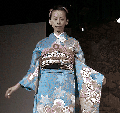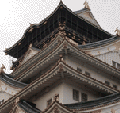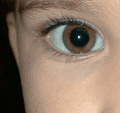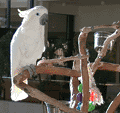|
Pentax Optio T30
Now for something different: a touchscreen interface
(by Conrad H. Blickenstorfer)
The Pentax T30 is an ultra-compact digital camera that has a touchscreen for menu navigation and image manipulation instead of buttons. From the front it looks like any other modern, elegant camera, but turn it around and you quickly see that this is a totally different animal.
The Pentax T-Series is unique insofar as virtually the entire interface is touch instead of using the conventional hardware buttons and controls. There is a huge 3-inch LCD with a touchscreen (see picture below) but all other controls are gone except for a menu button and a record/playback toggle. Now why would Pentax do that just when the industry has finally settled on a more or less standard button and control arrangement? And how difficult is it to figure it all out? Those are good questions. But keep in mind that the T30 is already the third touchscreen model Pentax offers. The T10 and T20 were very similar, so there must be enough demand for something bold and different to rapidly evolve the T-Series.
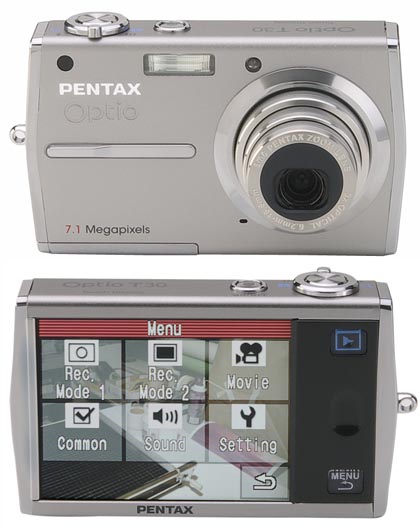
The camera itself
While the Optio T30's touchscreen is certainly the most noteworthy part of this camera and we'll discuss it in detail, let's quickly see what else you get. That would be a sleek, slender 7.1 megapixel ultra-compact with a 3X optical zoom. The 3-inch display would be a thrill and pleasure even if it did not have the touch interface, especially since it is not only large and bright, but also provides a 170 degree viewing angle from all sides. There is also a digital shake reduction mode that can boost ISO sensitivity all the way up to 3200. And the camera has all sorts of tricks and features.
The T30 is certain to attract attention wherever you go. It is a very elegant camera with a beautifully designed aluminum-alloy housing. Surfaces are a very fine powder-coated dark silver, accents are gleaming chrome and shiny black plastic. The design language of the T30 is mostly comprised of rectangles and crisply creased edges. There are some curves in it -- just enough to add a playful, modern look -- but for the most part the T30 is a very compact little box. It measures 3.7 x 2.2 inches and is just 0.7 inches thick, putting it roughly into the same size class as the Optio M30.
Designed for touchscreen operation
Unlike all other Optios -- and almost all other digital camers out there, period -- the Optio T30 requires some familiarization. You can just turn it on and start shooting pictures, as long as you stay in fully automatic mode. Anything else requires starting an acquaintance with the touchscreen interface. But before I get into that, let's take a walk around the T30.
On top are the on/off button, the shutter and the zoom. The on/off button has a green power indicator light in its center. Like some other current Optios, you can start up the camera in two modes. Normal by just pushing the power button, and a special playback-only mode where the lens barrel doesn't motor out and you can only view pictures, not shoot them. The round shutter sits in the center of a zoom ring. Pentax undoubtedly chose the combined zoom ring/shutter arrangement to remove one more control from the backside, keeping it as neat and clean as possible. The flipside of this coin is that this way you cannot both operate the zoom and have your finger on the shutter. I much prefer having my index finger on the shutter and my thumb on the zoom.
In the back you find ... not much. The massive 3-inch display totally dominates the rear. To its right is a glosssy, shiny black plastic panel with just two controls, a record/playback toggle and a menu button. Both are black as well and placed flush with the glossy surface. Between them is a smooth indent, presumably a guide for your thumb as you hold the camera. The whole backside is framed by a metal bezel, with the display being recessed into it. This makes for a less elegant, less high-tech look than would have easily been possible. Anyway, this is all you'll find on the back of the T30. No additional buttons, no navigational disc, nothing.
The right side has a strap lug in its center, flanked by the combined PC/AV jack and a DC jack for an optional power adapter. Both ports are protected with chromed plastic covers (see below) that cannot get lost, but are a bit difficult to pry open. The bottom has a slightly offcenter plastic tripod mount and then the combo storage card and battery compartment. The battery only goes in one way (seems simple and logical, but all too many cameras make you guess) and has a retainer clip. Storage is on a SD card, with an additional internal 20MB to tide you over.
The front doesn't have any controls, but the flash is flanked by two small circular windows. One is is the autofocus illuminator lamp, the other the sensor for an optional remote control.
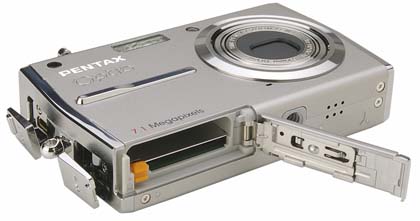
The touchscreen interface
The press has given the Optio T30's touchscreen interface generally very good marks. And for good reason. It's easier to use a consistent onscreen, icon-based menu by simply tapping on what you want than to use a variety of buttons and pointers to go to a menu selection and then push yet another button to select it. However logic and simplicity do not always win out. With computers we continue to use klunky keyboards designed in the 19th century to slow down typists on old typewriters instead of pens and voice, and Apple lost out to Microsoft despite a vastly better user interface.
Why is that? Well, with keyboards it's simply because we are so used to them. They are physical things that we learn. While they are infuriating, they are also simple, physical things. As opposed to such advanced, but iffy, concepts as handwriting or voice recognition, or a touch interface that relies on interaction between what you see on a screen, or not.
So did Pentax get it right with the touchscreen interface? Is it better than the conventional button/menu arrangement? The answer is, as almost always, a resounding "it depends." Unlike your ubiquitous button/menu camera, you need to play with the menus and get used to them. Things work a little differently. For the most part, everything is quicker and more direct, but not always. Pentax had the luxury to invent its own touchscreen interface; they were not locked in like, say, hardware companies that use Windows Mobile or the Palm OS.
There is an initial learning curve. It comes when you want to do things and the familiar buttons are simply not there. So you tap the screen and a set of opaque menu selections overlay the image. That's the touchscreen equivalent to pushing one of the four directional buttons of the navigation disc: Select scene, flash mode, drive mode, focus mode. But since options on a screen are not limited by the number of hardware keys, Pentax didn't have to stay with just four main options and chose to also add on the top menu screen access to a cool "memo pad" feature and the LCD display setting (off, no info, basic info, basic info plus histogram). One observation: given how large the LCD is, why not add a text description instad of just displaying an icon?
So far so good. The menus are very quick and simple. You can use a finger to operate them, or use a small white nylon stylus, similar to the ones that come with PDAs (unfortunately, there is no garage for it in the camera as all PDAs have, so it'll likely be lost almost instantly).
Interestingly, Pentax did not eliminate all buttons. The configuration and settings menus are still accessed via a good old-fashioned "Menu" hardware button. There really is not need for that, but so what. By and large, after a very brief acclimatization time, it's quicker to use the T30's touchscreen interface than the conventional buttons.
What would a touchscreen be without the ability to annotate or doodle? The Optio T30 offers that ability both on blank screens and on top of stored images. You can select the color, thichkness and brush type, and then draw or write onto your pictures. The ink doesn't move as quickly and smoothly as I'd like, but the feature can come in handy. You can also stamp little hearts and other glittery little things onto pictures. I am not so sure I need that, but it may come in handy when playing with kids.
Features
So the big touchscreen is great and the camera looks sleek and slender, but what else does it have to offer? Unfortunately, the concentration definitely is on the LCD and the touchscreen.
There is a digital anti-shake mode that operates by speeding up the shutter and boosting ISO sensitivity to make up for it. It works both for still pictures and with movies, but it is not an active sensor shift anti-shake system like the Optio A30 has.
The T30 has an autofocus illuminator lamp that makes for more precise metering and focusing in low light conditions. That is always welcome.
Those looking for any kind of manual modes are out of luck. In "P"rogram mode you change certain settings, but there is no shutter or aperture priority. There is a manual focus mode, and it happens to be something you need to figure out how to use as it is not obvious. You tap the screen, bring up focus mode, tap on "MF" for manual focus. You then get a rectangle on the display. You now tap inside that rectangle, the area inside the rectangle digitally magnifies to fill the display, and a focusing band appears at the bottom of the screen. There are no markings, just 0.15, 0.2, 0.3, 0.6 and infinite labels, and those are in meters.
Likewise, aficionados are super-macro modes won't find one. The standard macro mode lets you get as close as six inches or so - respectable, but often not close enough.
You do get good audio recording capabilities. There is a voice recording mode where you can record until the memory card is full. And you can attach up to 60 seconds of voice annotation to a picture. This function, of course, is handled via touch also.
The scene modes are useful, and when you tap on one, a small sample picture shows up, together with a brief explanation of what the mode is for and what it does.
Unlike all other current Optios, the T30 doesn't have a "Green Mode" and green button. In most Optios the green button is used to quickly toggle between a special scene mode and totally automatic (in the top-of-the-line A30 you can also assign other functions to the green button).
Playback mode menu
Th T30 lets you access 17 functions in playback mode. To access those, you tap the display. That first gets you into a top menu from where you can zoom, rotate, delete, add a frame (three are in the camera, more are downloadable for free), use digital ink to write or doodle on pictures, or enter the second level menus, called the "Playback Palette." From here you have access to a variety of filters, slide shows, the above mentioned voice annotation, red eye removal, resizing, movie edit, copying images between internal memory and storage card, setting an image as the startup picture, resize, crop, protect, and more. Playback zoom is up to 8X.
Software
On the software side the Optio A30 comes with ACDSee for Windows and the Mac OS. For the PC, that is version 6.0; on the Mac version 1.6.9 There is also an installer for the DivX 5.2.1 Codec and you can install DirectX if you don't already have it.
Everyday use
How well the Optio T30 fits into someone's life depends entirely on whether or not the unique touchscreen interface works for them. If it does, the T30 is an absolute pleasure to use. Just tap the screen to get things done. It's simple and quick. Those who can't get used to it have no fallback position as there are no buttons. Even the gorgeous 3-inch LCD then won't do any good.
Picture quality is very good under most conditions, and 7.1-megapixel are enough to be able to crop whatever is not needed. It is also enough for most enlargements. The camera takes excellent close-ups, though sometimes you just can't get close enough du to a lack of a super-macro mode. In low-light conditions, the autofocus illuminating light makes for improved exposure. And having a spare 20MB of onboard memory comes in handy when you run out of space on your SD memory card.
640 x 480 movies are recorded in QuickTime format. The digital zoom works very smoothly and the digital blur reduction mode works amazingly well. There aren't any cool tricks in movie mode, but for the most part we don't miss them.
Battery life is rated at just 200 pictures. That is not all that much, but also not surprising with such a large screen. Make sure you start every trip with a fully charged battery.
Bottom line
The Optio T30 is a camera that requires some getting used to as almost everything is done via a touchscreen instead of conventional buttons and levers. Once you practice a bit and become familiar with the different interface, the camera becomes extremely simple to use and operate. In fact, most operations are a lot quicker and easier to access with the touchscreen. To make the deal sweeter, Pentax threw in that terrific, huge 3-inch LCD with such a wide viewing angle that you can see the picture no matter what angle or direction you look at it. The camera is also sleek and attractive, and small and light enough to fit into a pocket.
The T30's emphasis is very clearly on the screen and touch interface, and those are superbly implemented. Anyone not interested in them may be disappointed in the camera's lack of a super-macro mode, active shake reduction or manual exposure modes. They should look at the Optio A30, a more conventional, costlier camera.
We like:
- Huge 3-inch wide viewing-angle LCD
- Touchscreen interface speeds up and simplifies
- Sleek and elegant design
- Digital shake reduction with ISO up to 3200
Not so much:
- Touchscreen operation has a learning curve
- No super-macro
- No green button
- No sensor shift shake reduction
|

